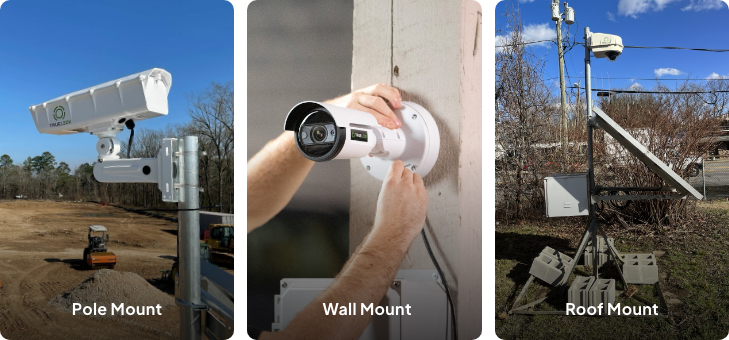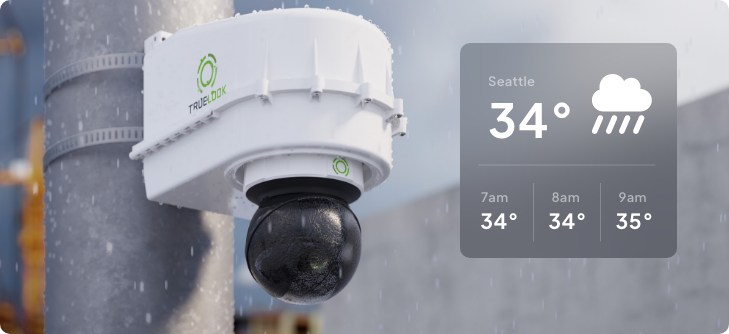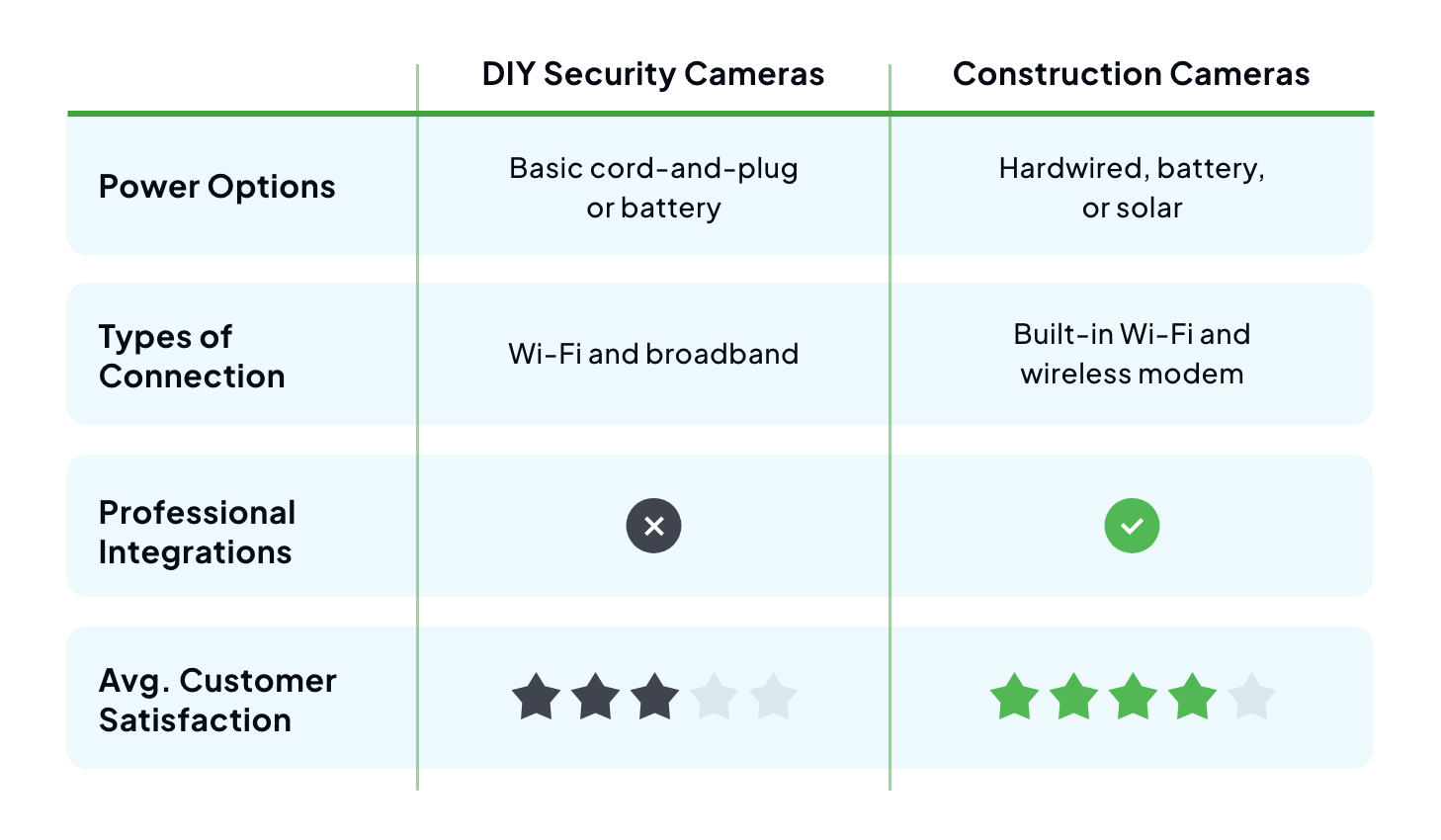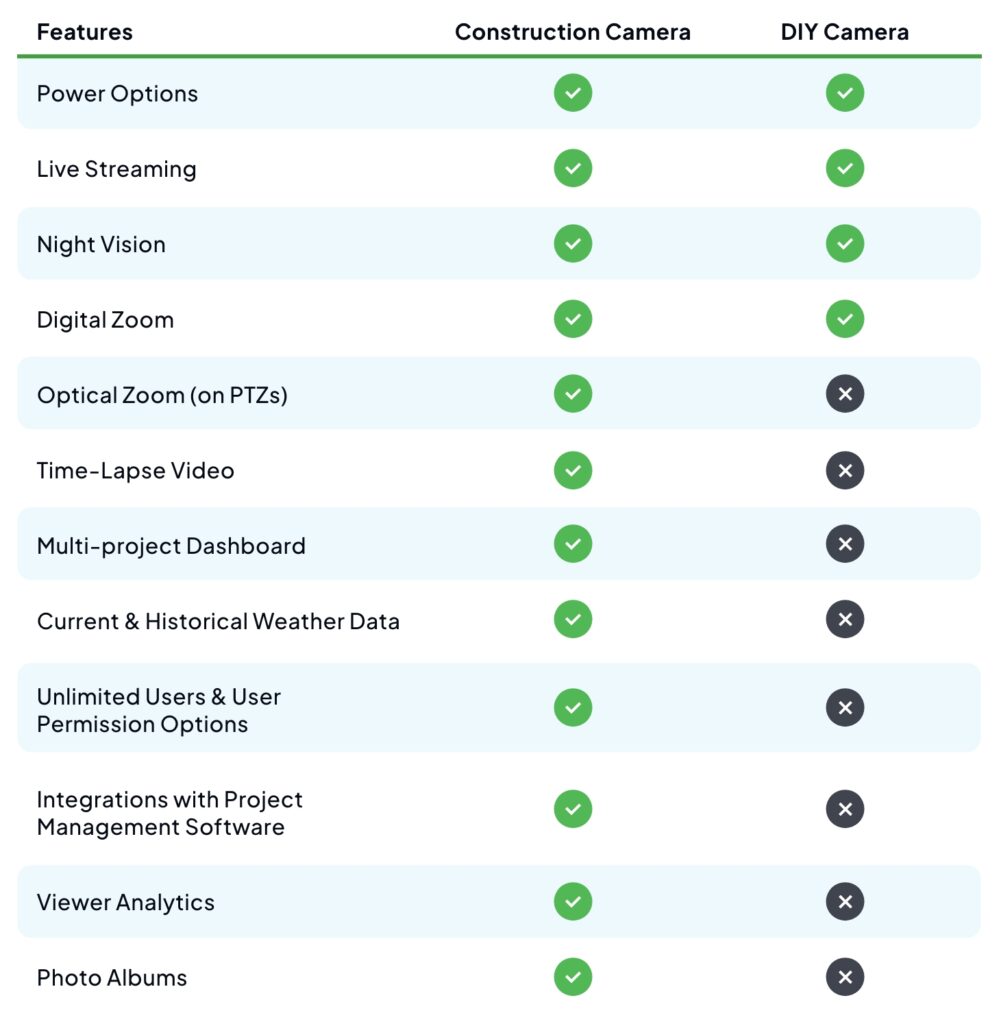Why DIY Cameras Fall Short in Construction Environments
See the comparison between the different types of cameras.
Introduction
Jobsite visibility is a cornerstone of successful construction project management. Simply put, better site visibility leads to better outcomes, including improved worker safety, site security, and project efficiency. Given these benefits, project managers across all sectors of the industry, including civil, residential, and commercial construction, are turning to construction cameras to improve visibility and secure their jobsites. Today, installing construction cameras has become best practice on the jobsite, helping project managers make informed real-time decisions, mitigate risks before incidents occur, document site activity for better compliance, and better manage and prevent security threats.
When it comes to choosing cameras for a construction project, there are a variety of camera options, ranging from professional-grade construction cameras to more consumer-grade do-it-yourself (DIY) cameras, such as Ring and Nest. While DIY cameras have become the default option for homeowners and residential builders looking to add an extra layer of security to their property, some commercial construction project managers are also turning to these cameras due to low costs and ease of installation. However, professional-grade construction cameras remain the standard for project documentation and security, offering a variety of advantages over DIY cameras ranging from better durability and environmental resistance to advanced integrations and data analytics.
In this guide, we will take a side-by-side look at professional-grade construction cameras vs. popular DIY cameras, examining where each option offers advantages over the other. We’ll discuss factors that you’ll want to consider before making your camera purchase and examine key comparison areas including durability, coverage, connectivity, power, data management, and integration capabilities.
| Category | Construction Camera | DIY Security System |
|---|---|---|
| Durability | Designed for long-term use with robust mounting options. | Generally less durable and lower quality mounting options, leaving them more susceptible to tampering and damage. |
| Weather Resistance | Superior weatherproof ratings, functioning in extreme conditions (-40˚ to 140˚F). Also has a higher IP Rating which means it can be temporarily submerged in water. | Lower weatherproof ratings, suited for milder conditions. Most IP ratings are insufficient for dusty outdoor jobsite environments. |
| Coverage | Most fixed models offer wide angles, and pan-tilt-zoom cameras offer a 360° viewing experience. Both provide a clear, undistorted image. | Some models offer up to 180° views, but with potential image distortion. Few 360° options exist. |
| Connectivity and Power | Offers 4G LTE, Ethernet, and Wi-Fi options, suitable for remote sites. Compatible with 110V or solar power with battery backup. | Relies on Wi-Fi and broadband, with primary power from 110V or batteries that require regular replacement or recharging. |
| Integration Capabilities | Extensive integrations with project management and other software designed specifically for construction sites. | Includes smart home integrations. No focus on construction-specific project management. |
| Price and Value | Higher initial cost, but offers long-term value through durability, reliability, and advanced features like time-lapse, photo documentation, and data analytics. Leasing options are also available and can help reduce upfront costs. | More affordable with a focus on flexibility and ease of installation, best suited for small residential projects with low-security risks. |
| Data Management and Analytics | Built for large-scale data capture with high-capacity storage and analytics tailored for construction, supporting compliance, and project tracking. | Less capacity for comprehensive site footage, focusing more on security alerts and remote access, with no project management support. |
| Installation | More complex due to robust mounting and power options, but can be done without any specialized skills. Installation can also typically be done by the construction camera company. | Simpler design for easy DIY installation, offering flexibility and portability, but less security. Installation can be done by local authorized subcontractors, but their knowledge and abilities may not be consistent. |
Key Areas of Comparison
Durability
Camera Mounting
One of the major differences in durability has to do with how the cameras are mounted. Construction cameras offer many options, including wall mounts, pole mounts, non-penetrating roof mounts, and mobile camera trailers. These options allow construction cameras to be placed in a wide variety of locations at varying heights using heavy-duty hardware. Construction camera vendors even offer guidance on the best camera placement for each jobsite and frequently offer their own installation services for an additional fee.
In comparison, many DIY cameras use wall mounts with adjustable or magnetic bases to secure the camera. While these DIY mounts are typically easier to install, they are also less durable, making them more susceptible to tampering, vandalism, and damage.

Weather Resistance
Construction sites are exposed to various weather conditions, including rain, wind, and extreme temperatures. Professional-grade construction cameras have higher weatherproof ratings than DIY security cameras, making them more resistant to environmental hazards like water, heat, and cold. DIY cameras with lower weatherproof ratings are more susceptible to breaking due to heavy rain or ice exposure and can even melt at high temperatures.

Dust and Debris Resistance
Construction cameras also have the edge when it comes to resisting damage from dust and debris that are common on jobsites. While some DIY cameras are designed to be moderately durable when it comes to common construction site hazards, they lack the more robust camera housings that make construction cameras well-suited for construction hazards. For example, Ring’s Stick Up Camera has a rating of IP55, meaning it’s not dust-tight or able to withstand temporary water immersion. If you want a camera that is going to hold up to jobsite conditions, a DIY camera won’t cut it.
Coverage
Camera coverage is crucial for maximizing jobsite visibility. Two main factors influence coverage: field of view and night vision.
Field of View
Some DIY camera models will offer fixed-position cameras with fields of view between 120–180° degrees, while fixed construction cameras often have a field of view that ranges lower, but is still considered wide-angle. The downside of a DIY camera with a high field of view is that the image is often distorted as the camera creates a fisheye effect. While DIY cameras may be suitable for smaller residential construction sites where clear imaging is less important, they may not provide optimal coverage for larger commercial sites. Having an undistorted image of your jobsite can help with identifying individuals on site, verifying deliveries, and investigating incidents. When it comes to maximizing jobsite visibility, construction cameras also have the edge over DIY cameras by offering pan-tilt-zoom models with 360° views.
Night Vision
Both construction cameras and DIY cameras offer night vision via infrared cameras. The difference between the two has to do with image quality. Construction cameras typically provide much clearer, high-quality images and can even come equipped with thermal visioning that enables viewing in absolute darkness or foggy and smokey conditions. It’s important to know that while some DIY cameras claim to have “color night vision,” it is impossible to capture full color images or videos during the night due to a lack of proper lighting for the lens.
Connectivity and Power
Connectivity and power are two major factors that construction project managers need to consider when deciding which camera options are a best fit for their jobsite. The ability to maintain robust connectivity is crucial, and you’ll want to ensure that your cameras have access to reliable power so they can stay up and running throughout the project.

Wifi and Wireless Connection
DIY cameras typically rely on Wi-Fi and broadband connection for data transmission, live viewing, and access to cloud storage. This makes DIY cameras convenient for residential or smaller-scale projects with reliable Wi-Fi connections. However, jobsites with spotty or no Wi-Fi connection will require an alternative option. Construction cameras offer more connectivity options, including Wi-Fi, Ethernet, and wireless cellular connection. This makes construction cameras the better choice for larger-scale or more remote projects where Wi-Fi connection is spotty or non-existent.
Wifi and Wireless Connection
DIY cameras typically rely on Wi-Fi and broadband connection for data transmission, live viewing, and access to cloud storage. This makes DIY cameras convenient for residential or smaller-scale projects with reliable Wi-Fi connections. However, jobsites with spotty or no Wi-Fi connection will require an alternative option. Construction cameras offer more connectivity options, including Wi-Fi, Ethernet, and wireless cellular connection. This makes construction cameras the better choice for larger-scale or more remote projects where Wi-Fi connection is spotty or non-existent.
Power Supply
DIY cameras are designed for easy installation and flexibility, which means they often rely on basic cord-and-plug wiring or replaceable and rechargeable batteries. Battery-powered cameras are convenient for portability and easy installation. However, because their batteries need to be replaced or recharged fairly frequently, they may not be suitable or efficient for longer-term use. Some DIY cameras also offer solar-powered cameras, but they do not come with a backup battery, making them less suited for jobsites where consistent coverage is necessary.
In comparison, construction cameras come with a variety of more robust power supply options, including 110V cord and plug, hardwired, and solar-powered with a backup battery. Cord and plug or hardwired cameras are a great solution for long-term projects, to make sure the cameras stay powered throughout the entirety of a project. Solar-powered cameras are becoming increasingly popular on jobsites that don’t have power. These cameras are paired with backup batteries and can offer long-term reliability and efficiency, even during cloudy days. In general, construction cameras are better suited for construction projects, where consistent documentation is paramount.
Price and Value
Price is where most DIY cameras have an advantage over professional-grade construction cameras. On average, DIY cameras are significantly cheaper than construction cameras. That being said, depending on the estimated duration of a project and the needs of your jobsite, construction cameras are worth the extra cost. Let’s take a look at the initial investment versus long-term value.
Initial Investment
DIY cameras might seem like a budget-friendly solution for smaller, short-term projects. However, it’s important to note that the initial cost may not tell the whole story. Hidden fees like mandatory subscriptions for extra data or storage can quickly add up. Plus, with the wear and tear of the jobsite, you might find yourself replacing DIY cameras more often than you’d like.
That’s why investing in construction cameras, despite the higher upfront cost, could be a smarter move in the long run. Leasing options are also common in the construction camera industry, allowing companies to spread out the cost of expensive equipment over time, making it more manageable for their budget. These cameras are built tough for jobsites, with features tailored specifically for construction projects. They offer better durability, construction-specific functions, and advanced capabilities, making them a solid investment.
Long Term Value
When it comes to long-term value, construction cameras outshine the DIY alternatives. Despite a higher initial cost, the robust features and durability of construction cameras justify the added investment, as these cameras are engineered specifically for the demands of construction sites and can be used across multiple jobsites over several years.
Additionally, investing in construction cameras proves particularly beneficial for projects enduring harsh conditions or located in high-risk areas prone to theft or vandalism. The increased resilience of these cameras translates to significant savings, potentially preventing expensive losses.
Features
A camera’s features are part of what makes them effective for managing security risks and improving project management. The following chart provides a comparison of specific features that are often available across the two different camera types.

Data Management
Effective data management is crucial for the success and compliance of any construction project. A well-organized system for tracking progress not only instills confidence in clients, but also ensures projects stay on course.
In the realm of data management, construction cameras reign supreme. Specifically designed to handle large volumes of footage, these cameras offer ample storage and specialized analytics features tailored to construction monitoring needs.
While DIY cameras offer storage capabilities, their primary focus tends to be on security. While they excel at providing real-time alerts and allowing project managers to view the jobsite without being physically there, they lack the robustness needed to store comprehensive site footage essential for meeting various project requirements.
Installation
Although not directly related to the camera’s functionality, ease of installation is a factor that many project managers consider when deciding what camera to purchase for their jobsite. DIY cameras offer an advantage due to their simpler design. These cameras are more flexible and portable than most construction cameras, making them easy to move from location to location if you need to relocate and reinstall. While it is also fairly easy to install construction cameras on your own, the more robust mounting and potential need for installing additional items, such as solar panels, makes them a bit more complex to install. The good news is that most construction camera vendors offer professional installation services, making installation a no-hassle process.
Integration Capabilities
Integrations are becoming an increasingly important part of camera technology, helping to make managing construction projects easier and more efficient. DIY cameras offer integrations with smart home systems, but the scope of those integrations is generally limited to residential use and lacks construction-specific integrations that can help project managers make better decisions and mitigate the risk of theft and injury.
In comparison, construction cameras offer extensive integration capabilities with project management and other construction technology tools, including Procore. These integrations can enable a more cohesive and efficient project management process, allowing for streamlined workflows, enhanced communication, and better jobsite visibility.
Conclusion
The benefits of using a construction camera outweigh the cost, making them an essential tool for jobsites.
Cameras have become an integral piece of managing successful construction projects. While some construction project managers are turning to DIY cameras due to their cheaper price points and ease of installation, most construction project managers will find more value in investing in professional-grade construction cameras.
Construction cameras have the edge in most features and functionalities, including durability, coverage, connectivity, power, integrations, data management, and features. While construction cameras have a higher price point, they more than make up for it by providing reliable, long-term value and improving the way project managers manage their projects.
